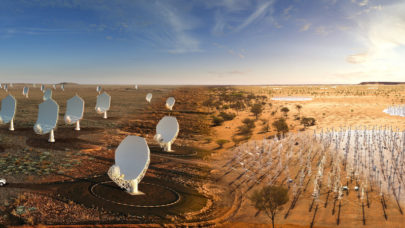
Pengchen Lab’s MadFS and Intel’s DAOS Shine in Latest IO500
July 7, 2021
An increasingly watched benchmark is the IO500 which measures storage system performance with an updated IO500 list released twice a year in concert with ISC an Read more…

How HPC is Shaking Up Modeling of Mysterious Earthquakes
July 6, 2021
Earth modeling is extraordinarily complex – and when the earth quakes, it’s no different. The mechanisms of many earthquakes consistently flummox seismologi Read more…

ISC21 Cluster Competition: Meet The Teams
July 5, 2021
The HPC Advisory Council and ISC jointly held their 10th annual Student Cluster Competition in a stylish virtual form factor over the past couple of months. T Read more…

Pawsey Prepares for the Data Deluge from the Square Kilometre Array
July 5, 2021
As the largest-ever radio telescope, the Square Kilometre Array (SKA) will be a behemoth. As the name implies, the instruments of the massive radio telescope will span well over one square kilometer, using hundreds of dishes and hundreds of thousands of low-frequency aperture array telescopes spread across remote lands in Australia and South Africa that have as little human radio interference as possible. Costing billions of dollars, construction... Read more…

ISC 2021’s Student Cluster Competition Winners Announced
July 2, 2021
Last year, there was an enormous upheaval: the Student Cluster Competition, which involves teams of students building computer clusters on the show floors of ISC and SC conferences, had to scramble to figure out a way to go virtual for ISC 2020. This year, at ISC 2021, it seemed almost second nature, with the conference even managing to pull a second remote... Read more…

ISC 2021 Keynote: Thomas Sterling on Urgent Computing, Big Machines, China Speculation
July 1, 2021
In a somewhat shortened version of his annual ISC keynote surveying the HPC landscape Thomas Sterling, lauded the community’s effort in bringing HPC to bear in the fight against the pandemic, welcomed the start of the exascale – if not yet exaflops – era with quick tour of some big machines, speculated a little on what China may be planning, and paid tribute to new and ongoing efforts to bring fresh talent into HPC. Sterling is a longtime HPC leader... Read more…

ISC 2021 Reveals Winners of Research Awards
June 30, 2021
Each year, the ISC High Performance Conference bestows a number of prestigious awards that recognize research excellence in high performance computing. Although Read more…

ISC21 Keynote: HPC-Powered Radar Tomography for Sustainable, Equitable Cities
June 29, 2021
ISC High Performance 2021 kicked off yesterday with a keynote from Dr. Xiaoxiang Zhu, a professor of data science and Earth observation at the Technical University of Munich. The conference, held virtually for the second time due to the ongoing coronavirus pandemic, featured a surprisingly COVID-light agenda... Read more…

- Click Here for More Headlines

Whitepaper
Transforming Industrial and Automotive Manufacturing
In this era, expansion in digital infrastructure capacity is inevitable. Parallel to this, climate change consciousness is also rising, making sustainability a mandatory part of the organization’s functioning. As computing workloads such as AI and HPC continue to surge, so does the energy consumption, posing environmental woes. IT departments within organizations have a crucial role in combating this challenge. They can significantly drive sustainable practices by influencing newer technologies and process adoption that aid in mitigating the effects of climate change.
While buying more sustainable IT solutions is an option, partnering with IT solutions providers, such and Lenovo and Intel, who are committed to sustainability and aiding customers in executing sustainability strategies is likely to be more impactful.
Learn how Lenovo and Intel, through their partnership, are strongly positioned to address this need with their innovations driving energy efficiency and environmental stewardship.
Download Now
Sponsored by Lenovo
Whitepaper
How Direct Liquid Cooling Improves Data Center Energy Efficiency
Data centers are experiencing increasing power consumption, space constraints and cooling demands due to the unprecedented computing power required by today’s chips and servers. HVAC cooling systems consume approximately 40% of a data center’s electricity. These systems traditionally use air conditioning, air handling and fans to cool the data center facility and IT equipment, ultimately resulting in high energy consumption and high carbon emissions. Data centers are moving to direct liquid cooled (DLC) systems to improve cooling efficiency thus lowering their PUE, operating expenses (OPEX) and carbon footprint.
This paper describes how CoolIT Systems (CoolIT) meets the need for improved energy efficiency in data centers and includes case studies that show how CoolIT’s DLC solutions improve energy efficiency, increase rack density, lower OPEX, and enable sustainability programs. CoolIT is the global market and innovation leader in scalable DLC solutions for the world’s most demanding computing environments. CoolIT’s end-to-end solutions meet the rising demand in cooling and the rising demand for energy efficiency.
Download Now
Sponsored by CoolIT
Advanced Scale Career Development & Workforce Enhancement Center
Featured Advanced Scale Jobs:
HPCwire Resource Library
HPCwire Product Showcase
© 2024 HPCwire. All Rights Reserved. A Tabor Communications Publication
HPCwire is a registered trademark of Tabor Communications, Inc. Use of this site is governed by our Terms of Use and Privacy Policy.
Reproduction in whole or in part in any form or medium without express written permission of Tabor Communications, Inc. is prohibited.
























